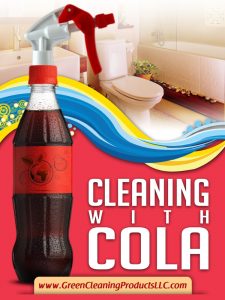There are many products that are hyped as alternatives to traditional products for natural green home cleaning. The questions that is often floating around is “Does it work?” and if it does, “How does it Work?” Many flaunt the benefits of cleaning with Coca-Cola or other colas.
 Since its introduced at Jacob’s Pharmacy in Atlanta, Georgia in 1886, Coca-Cola is everywhere. What once began as a health drink, is now one of the most recognized brands in the world. Today it is found in over 200 countries. In fact globally, the average person consumes a Coke product every four days (Coca-Cola currently has a product portfolio of more than 3,500 beverages under 500 different brands).
Since its introduced at Jacob’s Pharmacy in Atlanta, Georgia in 1886, Coca-Cola is everywhere. What once began as a health drink, is now one of the most recognized brands in the world. Today it is found in over 200 countries. In fact globally, the average person consumes a Coke product every four days (Coca-Cola currently has a product portfolio of more than 3,500 beverages under 500 different brands).
In the world of green cleaning many applications for cola are publicized, including:
- Shining up a tarnished copper penny
- Cleaning stains in toilet bowl
- Removing rust, especially from chrome on the bumpers of motorcycles and cars
- Taking out grease from clothes
For the science of cleaning, some of the benefits of cola that contributes to the ability of these natural green home cleaning strategies to work are:
- Low pH. Similarly, many cleaners are acidic. (The average pH of Coca-Cola, Pepsi, and other colas is 3.4.)
- Carbonation combined with the acid can dissolve the metal oxides and remove tarnish from copper, brass and other metal alloys.
- Citric acid is known to remove the stains
- Phosphoric acid is commonly used for rust removal.
- Carbonic acid dissolves limestone and may break down some of the mineral build-up.
As a mythbuster, some of the issues with its cleaning effectiveness, however, are:
- Cola is basically a carbonated syrup. It is sticky, no matter how you use it. Removing the stickiness applies in all applications.
- It is slow. Most applications say to soak it a long time, sometimes for a couple of hours, sometimes overnight, and in some cases even for a fortnight! Since we are usually seeking instant gratification, overnight is not a time frame we are seeking.
- While cola is good for removing tarnish on some metals, on others such as iron, tin and steel, it can corrode the metal.
- Since the phosphoric acid, citric acid, and carbonic acid in the cola is what does the cleaning. Much stronger more application specific solutions are available.
- Cost … if you need a liter or more to clean the toilet, a quart of Washroom Cleaner at the same price is more cost effective, since not as much is used for the same application.
As for the notion that the acid content of cola drinks makes them useful for various household cleaning purposes such as scrubbing toilets and removing grease from clothes, let’s just say there are plenty of more effective, less costly and decidedly less sticky alternatives available. In fact, Coca-Cola states “We don’t make any claims relating to other uses. Instead, we recommend using products specifically designed for cleaning or rust removal.” Green Cleaning Products can provide those application specific products to you.

Well, the claim is that the phosphoric acid combines with the rust to form a layer that prevents flash rusting. You did not address that issue. Also, overnight is no problem, and Coke is more available than other, specific acids.
Too, phosphoric acid (food acid 338) is the only acid mentioned in the ingredients. So, the citric acid seems a bit of a ring in. As for carbonic acid, when the coke goes flat, the only bit of the carbonic acid that will be left will be water. So, I think that you should have concentrated on phosphoric acid and its unique cleaning properties.
Correction: diet cokes have the other acids in them. So, you might have advised people that if they want the 338 effect, they should not choose diet cokes.
Will it clean plastic bathtubs?